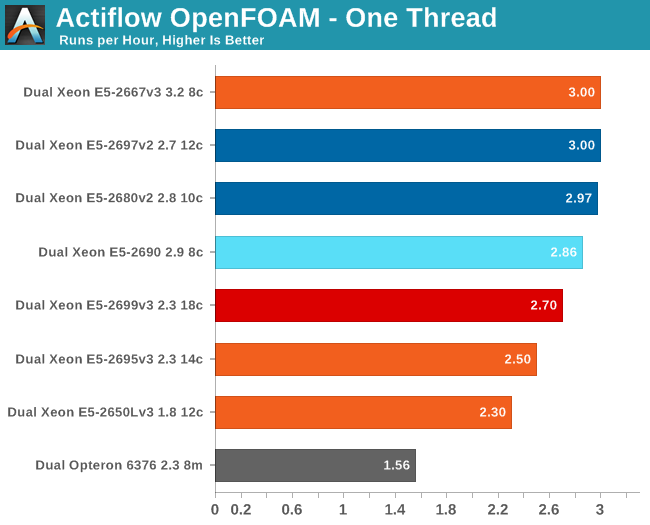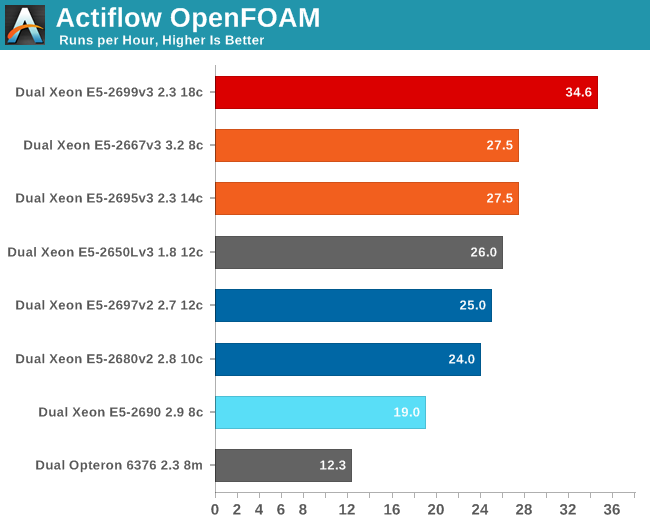Intel Xeon E5 Version 3: Up to 18 Haswell EP Cores
by Johan De Gelas on September 8, 2014 12:30 PM ESTOpenFoam
Computational Fluid Dynamics is a very important part of the HPC world. Several readers told us that we should look into OpenFoam, and my lab was able to work with the professionals of Actiflow. Actiflow specializes in combining aerodynamics and product design. Calculating aerodynamics involves the use of CFD software, and Actiflow uses OpenFoam to accomplish this. To give you an idea what these skilled engineers can do, they worked with Ferrari to improve the underbody airflow of the Ferrari 599 and increase its downforce.
We were allowed to use one of their test cases as a benchmark, but we are not allowed to discuss the specific solver. All tests were done on OpenFoam 2.2.1 and openmpi-1.6.3.
Many CFD calculations do not scale well on clusters, unless you use InfiniBand. InfiniBand switches are quite expensive and even then there are limits to scaling. We do not have an InfiniBand switch in the lab, unfortunately. Although it's not as low latency as InfiniBand, we do have a good 10G Ethernet infrastructure, which performs rather well. So we can compare our newest Xeon server with a basic cluster.
We also found AVX code inside OpenFoam 2.2.1, so we assume that this is one of the cases where AVX improves FP performance. To understand this real world test case better, we'll start with a single-threaded benchmark.

As this is AVX code, the clock speed "rules" change. A 2.3GHz Xeon E5 v3 can fall back to 1.9GHz if necessary, but it may also boost to 3.3GHz if the thermals allow it. The Xeon 2695 v3 has less TDP headroom and as a result it performs slightly slower than the Xeon E5-2699 v3. Still they cannot beat the Xeon E5-2667 v3 in single-threaded HPC performance. The latter is the better chip for this workload as it guarantees 2.7GHz and can boost up to 3.5GHz. As the previous Xeons also support AVX and run between 2.7 and 3.3GHz, they keep up with the Xeon E5-2667 v3.
Of course, most HPC code is now multi-threaded. We next ran OpenFOAM at one thread per physical core, which is about 5% faster than running with one thread per logical core (likely due to AVX).

If you work professionally with OpenFOAM, it is clear that it pays off to understand what a certain CPU offers. If money does not matter much, the Xeon E5-2699 v3 does what is has to, which is to beat everybody else despite the fact that OpenFOAM does not scale that well beyond a certain point.
To give you an idea of what we're seeing, with 16 threads on the Xeon E5-2699 v3 we were already running at 30 runs per hour. Despite the fact that our workload is already a pretty heavy one (>600k cells), it is clear you need a larger mesh to really use the best Xeons of today to their full potential.
A less expensive option is the Xeon E5-2667 v3, but the real winner here is the Xeon E5-2650L v3 which costs a full $1000 per CPU les than the Xeon E5-2695 v3 and consumes quite a bit less as we will see on the next page.










85 Comments
View All Comments
coburn_c - Monday, September 8, 2014 - link
MY God - It's full of transistors!Samus - Monday, September 8, 2014 - link
I wish there were socket 1150 Xeon's in this class. If I could replace my quad core with an Octacore...wireframed - Saturday, September 20, 2014 - link
If you can afford an 8-core CPU, I'm sure you can afford a S2011 board - it's like 15% of the price of the CPU, so the cost relative to the rest of the platform is negligible. :)Also, s1150 is dual-channel only. With that many cores, you'll want more bandwidth.
peevee - Wednesday, March 25, 2015 - link
For many, if not most workloads it will be faster to run 4 fast (4GHz) cores on 4 fast memory channels (DDR4-2400+) than 8 slow (2-3GHz) cores on 2 memory channels. Of course, if your workload consists of a lot of trigonometry (sine/cosine etc), or thread worksets completely fit into 2nd level cache (only 256k!), you may benefit from 8/2 config. But if you have one of those, I am eager to hear what it is.tech6 - Monday, September 8, 2014 - link
The 18 core SKU is great news for those trying to increase data center density. It should allow VM hosts with 512Gb+ of memory to operate efficiently even under demanding workloads. Given the new DDR4 memory bandwidth gains I wonder if the 18 core dual socket SKUs will make quad socket servers a niche product?Kevin G - Monday, September 8, 2014 - link
In fairness, quad socket was already a niche market.That and there will be quad socket version of these chips: E5-4600v3's.
wallysb01 - Monday, September 8, 2014 - link
My lord. My thought is that this really shows that v3 isn’t the slouch many thought it would be. An added 2 cores over v2 in the same price range and turbo boosting that appears to functioning a little better, plus the clock for clock improvements and move to DDR4 make for a nice step up when all combined.I’m surprised Intel went with an 18 core monster, but holy S&%T, if they can squeeze it in and make it function, why not.
Samus - Monday, September 8, 2014 - link
I feel for AMD, this just shows how far ahead Intel is :\Thermogenic - Monday, September 8, 2014 - link
Intel isn't just ahead - they've already won.olderkid - Monday, September 8, 2014 - link
AMD saw Intel behind them and they wondered how Intel fell so far back. But really Intel was just lapping them.